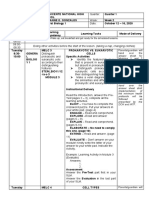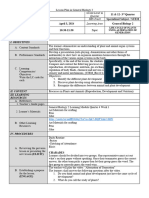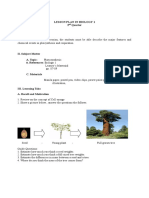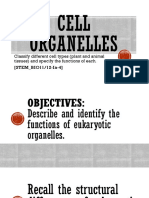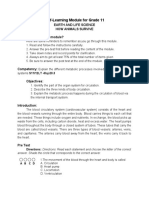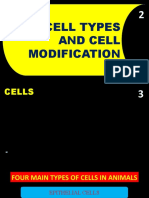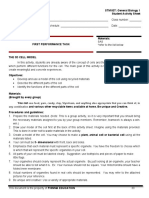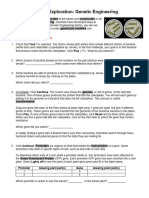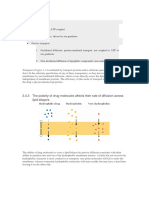Demo Lesson Plan General Biology
Demo Lesson Plan General Biology
Uploaded by
Michelle Ann C. DegranCopyright:
Available Formats
Demo Lesson Plan General Biology
Demo Lesson Plan General Biology
Uploaded by
Michelle Ann C. DegranOriginal Description:
Copyright
Available Formats
Share this document
Did you find this document useful?
Is this content inappropriate?
Copyright:
Available Formats
Demo Lesson Plan General Biology
Demo Lesson Plan General Biology
Uploaded by
Michelle Ann C. DegranCopyright:
Available Formats
Lesson Plan in General Biology 1
Content Cell
Content Standard The learners demonstrate an understanding of cell
structures and functions.
Performance Standard The learner shall be able to construct a 3D model of
plant/animal/bacterial cell using recyclable materials
Learning Competencies The learners describe the structure and function of major
and subcellular organelles
Code STEM_BIO11/12-Ia-c-2
I. Objectives:
At the end of the 60-minute discussion, the students should be able to:
1. describe the structure and function of different organelles in animal and plant
cells.
2. construct a model of a plant and animal cell .
3. appreciate the value of creativity, patience and teamwork in doing a task.
II. Subject Matter:
A. Topic: Anatomy of The Cell
B. Reference: Biology: Today and TomorrowFor Non-Science Majors
by Starr, Evers and Star, pages 49-55
C. Materials:
LCD Projector & Screen
Whiteboard and marker
Chalk
Supplies for Cell Model
D. Values: Creativity, Patience, Teamwork
III. Procedure
1. Routinary Activities
1. Greetings
2. Prayer
3. Checking of Attendance
4. Bio-Bits (Trivia of the Day)
2. Motivation
The class will be divided into five groups. Scrambled letters will be flashed on the screen
and the students should guess what the word is. Answers shall be written on the Meta
card given and paste it on the manila paper. The group with the highest point wins.
Scrambled Word Answer
SMAAITHT DEELISCHN MATTHIAS SCHLEIDEN
TERORB EKOHO ROBERT HOOKE
DOORTEHE NHAWCNS THEODORE SCHWANN
LELC RETHOY CELL THEORY
FODLUR WIVOCRH RUDOLF VIRCHOW
3. Lesson Proper
Using a PowerPoint presentation, the teacher will present the topic using active learning
and/or collaborative learning.
4. Generalization
The cell is considered the basic unit of life. Organelles are small structures within cells
that have specific jobs that include ribosomes, endoplasmic reticulum, Golgi
apparatus, vacuoles, lysosomes, mitochondria, plasma membrane and others.
5. Application
Cell Model Construction
The class will be divided into five groups. Using the available materials they have on
hand, the students will construct their model within 10 minutes. After the time given,
the teacher will choose the best model.
IV. Evaluation
The group will going to present their output using the teacher-made rubric. (see
attached rubric)
V. Assignment
Draw and label the parts of an animal and plant cell.
Prepared by:
Michelle Ann C. Degran
Group No. ______ Date: ______
Section: ________
Name of the Members:
1. ___________________ 4. ___________________
2. ___________________ 5. ___________________
3. ___________________ 6. ___________________
3D CELL MODEL RUBRICS (SCORE SHEET)
Cell Type: ________
Grade: ________ out of 30 Rubric points x 100 = __________ %
Model Criteria Excellent (5) Great (4) Good (3) Fair (2) Poor (1)
Creativity & Model is 3-D. Model is 3-D. Model is 3-D. Model is 3-D. Model is not 3-
Design Uses different Uses different Uses different Organelles are D.No edible
edible edible materials edible all made out material is
materials for for each materials for of the same used.
each organelle. organelle. Cell each edible
Cell proper proper shape. organelle. Cell material.
shape. not proper
Imaginative. shape.
Labels Name, period, Missing one Missing two Missing more Organelles not
cell type element: name, elements: than two labeled on
present. All period, cell name, period, elements: model.
organelles type, organelle cell type, name, period, Difficult to
labeled neatly label organelle cell type, read and
and legible on Legible and labels organelle understand.
model. neat Neatly labeled. labels. Not
neat.
Organelles All required Missing, Missing two Missing three Missing three
organelles misplacement, organelles or more or more
shown. Proper improper size or from cell. Most organelles. organelles.
size, shape and shape of one organelles Most Most
placement in organelle in cell. proper shape, organelles organelles not
the cell. Including an size and proper shape, proper shape,
extra organelle. placement. size and size or
placement. placement in
the cell.
Key Criteria Excellent (5) Great (4) Good (3) Fair (2) Poor (1)
Functions All organelle One organelle Missing two Missing three Missing four or
functions are function missing organelle organelle more organelle
correct for cell or incorrect. functions. functions. Not functions. Key
model. Neat Extra organelle Neatly written. neatly written. is difficult to
and legible. function added read.
Identification All organelles All organelles Most Most Organelles are
are correctly are correctly organelles are organelles are not labeled on
labeled. labeled. Pictures correctly NOT correctly key.
Sample drawn to labeled and labeled and do
organelle on represent match model. NOT match
key. Match organelles. model.
model.
Presentation Excellent (5) Great (4) Good (3) Fair (2) Poor (1)
Part & Function Discusses all Does not Does not Does not Does not
cell parts and explain one explain two explain three explain four or
functions. organelle or its organelles or organelles or more
Explains what function. their their functions organelles or
was used for functions. their functions.
each organelle. Does not
present
project.
Total Points
You might also like
- Demo Lesson Plan - General Biology 1Document5 pagesDemo Lesson Plan - General Biology 1LJ Valdez96% (23)
- Mitosis Lesson Plan Using 7e'sDocument4 pagesMitosis Lesson Plan Using 7e'sGregorio Rizaldy80% (5)
- Template DLP BioenergeticsDocument9 pagesTemplate DLP Bioenergeticsargie joy marie100% (3)
- DLL General Biology 1 Quarter 1 Week 1Document4 pagesDLL General Biology 1 Quarter 1 Week 1Rubin RubinNo ratings yet
- Pharmacology - Mechanism of Action of All Drugs - +Document4 pagesPharmacology - Mechanism of Action of All Drugs - +Sahal ShaikhNo ratings yet
- DLP Gen Bio 2Document8 pagesDLP Gen Bio 2Delz NoblezaNo ratings yet
- Gen Bio 2 Lec PPT - 1795379778Document502 pagesGen Bio 2 Lec PPT - 1795379778Rey Ann ConcepcionNo ratings yet
- Whole Brain Learning System Outcome-Based Education: General Biology 1Document9 pagesWhole Brain Learning System Outcome-Based Education: General Biology 1Rei-Rei RamosNo ratings yet
- UNIT 2 Notes PDFDocument88 pagesUNIT 2 Notes PDFAjNo ratings yet
- Learning Plan Genbio 2 Week 1Document5 pagesLearning Plan Genbio 2 Week 1Albert Rosete100% (1)
- General Biology 2 Evolutionary RelationshipDocument3 pagesGeneral Biology 2 Evolutionary RelationshipLowel AndrewNo ratings yet
- DLP Gas Exchange in Plants and Animals - Q4 WK4 COT SAN CARLOS DIVISIONDocument8 pagesDLP Gas Exchange in Plants and Animals - Q4 WK4 COT SAN CARLOS DIVISIONjulzhaide100% (1)
- DLP Gen - BiologyDocument4 pagesDLP Gen - BiologyGina Ano IsidroNo ratings yet
- Lesson 8 - Membrane Transport - Passive TransportDocument3 pagesLesson 8 - Membrane Transport - Passive TransportEarl Caesar Quiba PagunsanNo ratings yet
- Lesson 2 - Prokaryotic VS Eukaryotic CellsDocument3 pagesLesson 2 - Prokaryotic VS Eukaryotic CellsEarl Caesar Quiba Pagunsan100% (2)
- My COTDocument3 pagesMy COTShellane Blanco SarduaNo ratings yet
- DDL in Gen Bio With AnnotationsDocument8 pagesDDL in Gen Bio With AnnotationsEarl Caesar Quiba Pagunsan100% (1)
- 11-16-15 Cell Theory Lesson PlanDocument5 pages11-16-15 Cell Theory Lesson Planapi-292269738No ratings yet
- LP1 The Cell TheoryDocument3 pagesLP1 The Cell TheoryPaulus VillanuevaNo ratings yet
- DLL Shs Stem Grade 12general Biology1 Quarter1 Week1 Palawan Division 1 PDF FreeDocument13 pagesDLL Shs Stem Grade 12general Biology1 Quarter1 Week1 Palawan Division 1 PDF FreeJinky AydallaNo ratings yet
- DLP in Gen Biology IIDocument17 pagesDLP in Gen Biology IIMhimi Viduya100% (1)
- Cell OrganellesDocument3 pagesCell OrganellesYamyang Galay-BañoNo ratings yet
- Gen Bio 1 Le Week 4 - Quarter 2Document8 pagesGen Bio 1 Le Week 4 - Quarter 2Cassy Joy RellamaNo ratings yet
- DLL EvolutionDocument2 pagesDLL EvolutionLawrence G. de Roxas100% (2)
- STEM - BIO11 12 Id F 7Document4 pagesSTEM - BIO11 12 Id F 7Michael Conan MaglaqueNo ratings yet
- 4 A's Lesson PlanDocument4 pages4 A's Lesson PlanMayolita NavalloNo ratings yet
- Wake Up, Eat Breakfast and Get Ready For The Scheduled LessonsDocument2 pagesWake Up, Eat Breakfast and Get Ready For The Scheduled LessonsMarianne GonzalesNo ratings yet
- Grade-12 General-Biology2 Q3 Module 5 Systematics Based On Evolutionary Relationships.-For-PrintingDocument9 pagesGrade-12 General-Biology2 Q3 Module 5 Systematics Based On Evolutionary Relationships.-For-Printingairamaymalicdem052No ratings yet
- DLP April 3 GenBio2Document2 pagesDLP April 3 GenBio2sherlockdrnNo ratings yet
- DLP GlycolysisDocument3 pagesDLP GlycolysisMichelle NicolasNo ratings yet
- Lesson Plan in Biology 1 2 QuarterDocument3 pagesLesson Plan in Biology 1 2 QuarterLieshaNo ratings yet
- General Biology 2 DLL October 01 and October 02 2018Document4 pagesGeneral Biology 2 DLL October 01 and October 02 2018Ivy AguasNo ratings yet
- LC 63Document3 pagesLC 63JT SaguinNo ratings yet
- General BiolologyDocument20 pagesGeneral BiolologyLaivey Ligan Luig Lemeric0% (1)
- Detailed Lesson Plan in General Biology 2Document2 pagesDetailed Lesson Plan in General Biology 2brinda100% (2)
- Module General Biology 1 Week 2 SHS 2Document35 pagesModule General Biology 1 Week 2 SHS 2yeon gyuuNo ratings yet
- CIDAM (Gen Bio) MELCDocument4 pagesCIDAM (Gen Bio) MELCSab Ibarreta100% (1)
- DLL General Biology 1 Quarter 1 Week 5Document4 pagesDLL General Biology 1 Quarter 1 Week 5Rubin RubinNo ratings yet
- Cell Organelles: Classify Different Cell Types (Plant and Animal Tissues) and Specify The Functions of EachDocument42 pagesCell Organelles: Classify Different Cell Types (Plant and Animal Tissues) and Specify The Functions of EachTatingJainarNo ratings yet
- General Biology1 WHLP-1Document3 pagesGeneral Biology1 WHLP-1Angelika BernalNo ratings yet
- Lesson Plan On NutritionDocument4 pagesLesson Plan On NutritionJENNY MAY SUDAY100% (1)
- Self-Learning Module For Grade 11: Earth and Life Science How Animals Survive How Will You Use This Module?Document8 pagesSelf-Learning Module For Grade 11: Earth and Life Science How Animals Survive How Will You Use This Module?MIMOYOUNo ratings yet
- 2nd SEM 2020-SAC SHS FIDP Final - BIOLOGY 2Document12 pages2nd SEM 2020-SAC SHS FIDP Final - BIOLOGY 2ZERILLE ANNE INSON AGREGADONo ratings yet
- Cell Types and Cell ModificationDocument29 pagesCell Types and Cell ModificationVictous WarbingerNo ratings yet
- DLL Transport SystemDocument2 pagesDLL Transport SystemRei-Rei RamosNo ratings yet
- Senior High School: Learning Module inDocument14 pagesSenior High School: Learning Module inHannahEsparagosaNo ratings yet
- Subject Orientation Grade 11 Gen Bio UpdatedDocument2 pagesSubject Orientation Grade 11 Gen Bio UpdatedArlance Sandra Marie Medina100% (1)
- Plant and Animal Organ System and Their FunctionsDocument44 pagesPlant and Animal Organ System and Their FunctionsClara MaeNo ratings yet
- Exemplar Science Lesson Plan For Senior High School General Biology 1Document4 pagesExemplar Science Lesson Plan For Senior High School General Biology 1LG NiegasNo ratings yet
- Fidp Earth and Life ScienceDocument9 pagesFidp Earth and Life ScienceJoana AbalosNo ratings yet
- Detailed Lesson Plan in Grade 11 Earth and Life ScienceDocument7 pagesDetailed Lesson Plan in Grade 11 Earth and Life Sciencemedsdelfrancis.cenizaNo ratings yet
- DLL TissueDocument2 pagesDLL TissueRei-Rei RamosNo ratings yet
- Minerals Around Us!: Learner's Activity Sheet in Earth and Life ScienceDocument12 pagesMinerals Around Us!: Learner's Activity Sheet in Earth and Life ScienceMiguel BabarinNo ratings yet
- CO - Earth and Life Science (Detailed Lesson Plan)Document6 pagesCO - Earth and Life Science (Detailed Lesson Plan)L.G. MaquirangNo ratings yet
- At The End of This Cell Theory Lesson PlanDocument5 pagesAt The End of This Cell Theory Lesson PlanJohn Carl Angelo EstrellaNo ratings yet
- A Semi-Detailed Lesson Plan in General Biology-IiDocument17 pagesA Semi-Detailed Lesson Plan in General Biology-IiMhimi ViduyaNo ratings yet
- LC 4Document4 pagesLC 4JT SaguinNo ratings yet
- DLL General Biology 1 Week 1 Quarter 3Document3 pagesDLL General Biology 1 Week 1 Quarter 3Mark Anthony TenazasNo ratings yet
- Week 6 (Earth Science)Document10 pagesWeek 6 (Earth Science)wendel junioNo ratings yet
- DLL 4th BIOLOGY G8Document4 pagesDLL 4th BIOLOGY G8Jane Limsan PaglinawanNo ratings yet
- ELS - DLL - Module 4 - GENETIC ENGINEERINGDocument7 pagesELS - DLL - Module 4 - GENETIC ENGINEERINGMitze QuinonesNo ratings yet
- LP Gen - Bio 1Document5 pagesLP Gen - Bio 1Ivan BrilataNo ratings yet
- STM 007 Ptask GuidelinesDocument5 pagesSTM 007 Ptask GuidelinesJeff Zach PerezNo ratings yet
- 1.2 Ultrastructure of Cells, 1.2.U2: Activity 1Document3 pages1.2 Ultrastructure of Cells, 1.2.U2: Activity 1Jaime MallaNo ratings yet
- Elk BioDocument8 pagesElk Bioapi-399013722No ratings yet
- Plant Anatomy Ruel-VelosoDocument70 pagesPlant Anatomy Ruel-VelosoKhy Renz BajajNo ratings yet
- The Connaissance Grand Scholastic Tome Part IDocument296 pagesThe Connaissance Grand Scholastic Tome Part IJohncel James Dela Rosa100% (2)
- Virus Replication: John Goulding, Imperial College London, UKDocument1 pageVirus Replication: John Goulding, Imperial College London, UKnawal asmadiNo ratings yet
- The Fluid Mosaic Model: Phospholipid BilayerDocument3 pagesThe Fluid Mosaic Model: Phospholipid BilayerSmarika NiraulaNo ratings yet
- All About Facility Layout and SchedulingDocument46 pagesAll About Facility Layout and Schedulingshihabrahman008No ratings yet
- Cell The Unit of Life PowerNotes by KT SirDocument2 pagesCell The Unit of Life PowerNotes by KT Sirronakbhardwaj682100% (1)
- GeneticEngineering GizmoDocument4 pagesGeneticEngineering GizmokallenbachcarterNo ratings yet
- BIO101 General Biology IDocument14 pagesBIO101 General Biology Imabelgodfrey467No ratings yet
- Bioxplorer - List of The Avalable E-BooksDocument5 pagesBioxplorer - List of The Avalable E-BooksfjbgohofjbvgNo ratings yet
- Modules in Microbiology 1 5 MidtermsDocument100 pagesModules in Microbiology 1 5 MidtermsJinn Allan LuañaNo ratings yet
- BIO50A IDR Subtopic2.7 QPDocument3 pagesBIO50A IDR Subtopic2.7 QPkNo ratings yet
- Final Microbes Definition Edits 1Document9 pagesFinal Microbes Definition Edits 1api-510503468No ratings yet
- Cell Structures and Their FunctionsDocument7 pagesCell Structures and Their FunctionsClarence MallariNo ratings yet
- ELS Reviewer 2022 2023Document6 pagesELS Reviewer 2022 2023Aleph AninacionNo ratings yet
- Life ProcessDocument31 pagesLife ProcessThaw ThawNo ratings yet
- CH3 cell structure and functionDocument5 pagesCH3 cell structure and functioneugeneasunNo ratings yet
- Chapter 3: Cell Structure and Internal Compartments: Key ConceptsDocument5 pagesChapter 3: Cell Structure and Internal Compartments: Key ConceptsFrancis PhimphivongNo ratings yet
- Pathogen Song LyricsDocument1 pagePathogen Song LyricsBenjie Modelo ManilaNo ratings yet
- Earth and Life Science Q2 Handouts 1 Life and CellsDocument2 pagesEarth and Life Science Q2 Handouts 1 Life and Cellshiraethnixaley07No ratings yet
- Cells and The Cell TheoryDocument28 pagesCells and The Cell TheoryJanin CodillaNo ratings yet
- Drug and Membranes Extension NotesDocument6 pagesDrug and Membranes Extension NotesDylan AdlardNo ratings yet
- Biology - WBJEEMed - Ques With Ans Keys PDFDocument11 pagesBiology - WBJEEMed - Ques With Ans Keys PDFMarcus RashfordNo ratings yet
- Test Bank: For Brock Biology of Microorganisms 16th Edition by Madigan (All Chapters Complete Edition) Chapters 1-34Document42 pagesTest Bank: For Brock Biology of Microorganisms 16th Edition by Madigan (All Chapters Complete Edition) Chapters 1-34kcb.antonioNo ratings yet
- GegDocument126 pagesGegRicardo RodriguesNo ratings yet
- BiotechnologyDocument153 pagesBiotechnologyMatin Ahmad KhanNo ratings yet


























